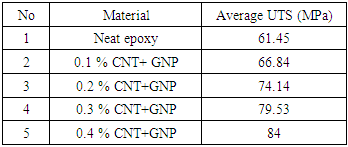-
Paper Information
- Paper Submission
-
Journal Information
- About This Journal
- Editorial Board
- Current Issue
- Archive
- Author Guidelines
- Contact Us
American Journal of Materials Science
p-ISSN: 2162-9382 e-ISSN: 2162-8424
2016; 6(6): 157-165
doi:10.5923/j.materials.20160606.03

Mechanical and Electrical Properties of Graphene Nanoplates and Carbon-Nanotubes Hybrid Epoxy Nanocomposites
Ahmed A. Moosa1, Ahmad Ramazani S. A.2, Mohammed Nabil Ibrahim1
1Department of Materials Engineering Technology, Engineering Technical College, Baghdad, Middle Technical University Baghdad, Iraq
2Department of Chemical and Petroleum Engineering, Sharif University of Technology, Tehran, Iran
Correspondence to: Ahmed A. Moosa, Department of Materials Engineering Technology, Engineering Technical College, Baghdad, Middle Technical University Baghdad, Iraq.
| Email: |  |
Copyright © 2016 Scientific & Academic Publishing. All Rights Reserved.
This work is licensed under the Creative Commons Attribution International License (CC BY).
http://creativecommons.org/licenses/by/4.0/

Carbon nanomaterials have attracted tremendous interest as a nano-filler for epoxy nanocomposites due to their excellent properties. The efficient reinforcement has been largely limited by the agglomeration of these nano-fillers within epoxy matrix. In this work, shear mixing followed by sonication is used to prepare CNTs+GNPs/epoxy hybrid composites. The epoxy reinforced with nano-filler CNTs+GNPs (CNTs+GNPs /epoxy) hybrid composites were prepared by mixing (0.1, 0.2, 0.3, 0.4) wt% of (CNTs+GNPs) with epoxy at (CNTs: GNPs) ratio of (1:1). The tensile properties, contact angle and electrical conductivity were measured. A remarkable synergetic effect between the GNPs and CNTs in improving the mechanical properties and electrical conductivity of epoxy composites is demonstrated.
Keywords: Epoxy, Mechanical Properties, Electrical conductivity, Nanocomposites, Hybrid, CNT-GNP/epoxy
Cite this paper: Ahmed A. Moosa, Ahmad Ramazani S. A., Mohammed Nabil Ibrahim, Mechanical and Electrical Properties of Graphene Nanoplates and Carbon-Nanotubes Hybrid Epoxy Nanocomposites, American Journal of Materials Science, Vol. 6 No. 6, 2016, pp. 157-165. doi: 10.5923/j.materials.20160606.03.
Article Outline
1. Introduction
- Carbon nanomaterials such as Carbon Nanotubes (CNTs) and Graphene Nanoplatelets (GNPs) can be used as a nanofillers in polymer nanocomposites because of their excellent mechanical and electrical properties [1, 2] and their high aspect ratio [3, 4]. The strong van der Waals forces between these nanofillers resulted in poor dispersion of nanofiller in polymer matrix [5]. The poor dispersion of carbon nanofillers and the high cost of carbon nanofillers are two critical issues for the applications of polymer nanocomposites with carbon nanofillers [6].CNTs are one dimensional carbon materials with very high aspect ratio greater than 1000 with diameters in nanometer scale [7]. Graphene [8] which is a new class of carbon allotropes, is an atomically thick, two-dimensional sheet composed of sp2- hybridized carbon atoms packed in a honeycomb network [9]. Graphene has excellent thermal conductivity (5000 Wm-1 K-1) [10], electrical conductivity, 1738 siemens per meter for coated layer, [11], excellent mechanical properties with Young’s modulus of elasticity 1 TPa, ultimate tensile strength of 130 GPa [12] and extremely high surface area (theoretical limit: 2630m2/g) [13]. These excellent properties make graphene to have great potential to improving electrical, mechanical, and thermal properties of polymers.The potential applications of CNTs and GNPs are limited because CNTs are easy agglomerate due to their large aspect ratio and GNPs also tend to restack due to their large van der Waals and strong π–π interactions [14-16]. Thus, the challenging task to successfully explore the structural composites lies in achieving homogeneous dispersion of CNTs and GNPs in the polymer matrix.The hybrid nanocomposites have been widely developed where two or more nanofillers fillers are used for improving composite properties by combining the advantages of each filler such and MWCNT with GNPs [16]. Graphene nano-platelets are expected to increase thermal conductivity by providing 2D path for phonon transmission, while MWCNTs are expected to increase electrical conductivity of polymer material [16-18]. Significant improvement in the mechanical properties of CNTs/GNPs epoxy hybrid composites have been recently reported [19].The main goal of this research is to study synergistic effects of CNTs and GNPs nanofillers on the mechanical and electrical properties of the epoxy hybrid structures. CNTs+GNPs/epoxy hybrid nanocomposites were prepared by shear mixing followed by sonication.
2. Experimental Work
2.1. Materials
- Functionalized Multiwalled Carbon Nanotube (FMWCNT, with purity > 95 wt%, outside diameter 10-30 nm and length 30 μm). The graphene Nanoplates (GNPs) grade-C was purchased from XG science company, USA and obtained from Cheap Tube Inc., USA. The GNPs were 97% pure and consist of 4-5 graphene layers with an average thickness of 8 nm and an average diameter of 2 microns while their average surface area was about 500-750 m²/g. The epoxy material and the hardener were purchased from (Mokarrar Engineering Materials Co., Iran). The epoxy is low viscosity diglycidyl ether bisphenol A, (DGEBA) with commercial name, ML-506 (density = 1.1 g/cm3, viscosity = 1450 centipoise). The hardener used is a polyamine hardener, HA-11. The epoxy to hardener mixing ratio is 100:15.
2.2. Preparation of Nanocomposites
- The experimental work was done at the Bio-Technology laboratory/Institute for Nanoscience and Nanotechnology (INST)-Sharif University of Technology/Tehran/Iran. The epoxy reinforced with Functionalized multiwalled carbon nanotubes and graphen nanoplates (CNT-GNP/Epoxy) were prepared by mixing (0.1, 0.2, 0.3, 0.4) wt% of (CNTs+GNPs) with epoxy. The (CNT: GNP) ratio was taken as (1:1). The nanocomposite were prepared by direct mixing of nanofiller with epoxy resin using high speed mixer (Ultra-Turrax, Germany) at 3000 rpm for 15 min. [20]. Ultrasonicator (UP400S, Germany) was used in order to disperse CNT-GNP nannofillers into an epoxy resin at 200Wpower and 25 kHz frequency in an ice-water for 20 min. The hardener was then added with a ratio 100:15 wt.% (resin: hardener). The CNTs+GNPs/epoxy mixture was then centrifuged (EB series, Centurion Scientific, Germany) at speeds of 3,000 rpm for two minutes to remove the bubble and was then poured into the mold with dimensions (200x180x3) mm and left for 24 hours to complete the curing process. The CNTs+GNPs/epoxy nanocomposite was then heated for three hours in an oven at a temperature of 80°C for post-cure. The CNTs+GNPs/epoxy nanocomposite were then cut using laser cutting machine (Laser engraving & cutting machine PN6040, China) for tensile test samples in accordance with ASTM D-638) and for electrical conductivity measurements.
2.3. Characterization and Instruments
- The Field Emission Scanning Electron Microscope (FESEM) with spatial resolution down to 1.5 nm (Mira 3 Tescan FESEM, Czech) was used for characterization of the MWCNTs, GNP and the morphology of fractured surface of tensile sample of the epoxy nanocomposites. The tensile test specimens were tested using Universal testing machine (HIWA 200, Korea) at maximum load 5000 kgf and maximum speed 500 mm/min. The electrical conductivity of the nanocomposites was measured using Agilent 4294A Precision Impedance Analyzer, in the range 5Hz to 50MHz. Different applied voltage were used through the upper and the lower surface of the sample. Then, the capacitance, resistance, and dielectric constant across the sample were measured.
3. Results and Discussion
3.1. Morphology of MWCNTs and Graphene
- The functionalized CNTs and the GNPs were imaged by FESEM as shown in Figure 1(a and b). The image of MWCNTs clearly shows some catalysts particles remained from CVD preparation method. The average diameter of CNTs is about 24 nm.
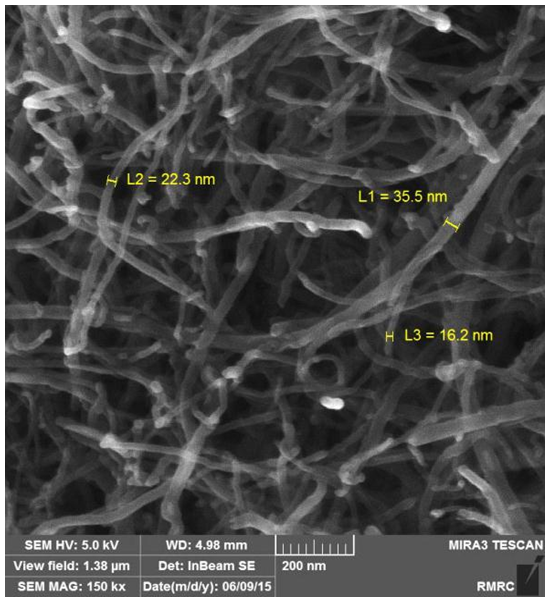 | Figure 1(a). FESEM of CNTs |
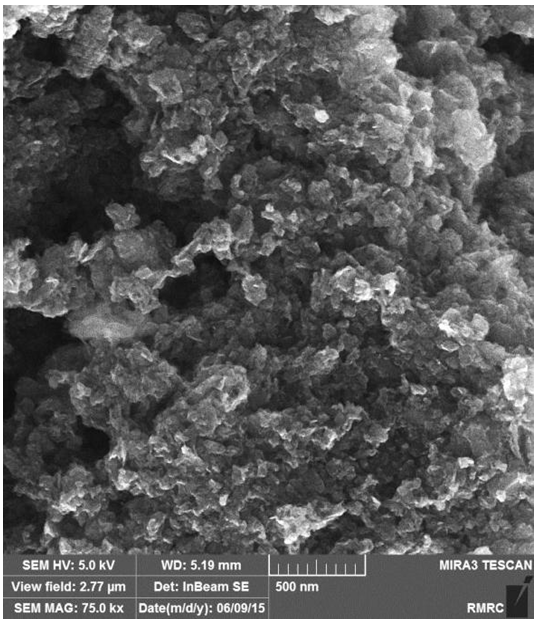 | Figure 1(b). FESEM of Graphene Nanoplates |
3.2. Tensile Properties of CNT- GNP/ Epoxy Composite
- The stress-strain curves of CNTs+GNPs/epoxy nanocomposites with (0.1, 0.2 0.3, 0.4wt% CNT/GNP) at mixing ratio (1:1) are shown in Figure 2. The ultimate tensile strength increases from 61.45 MPa for neat epoxy to 84 MPa composites at 0.4% CNTs+GNPs. This is a 36% increases compared to that of the neat epoxy as shown in Table 1. Little reduction in strain to break was observed.
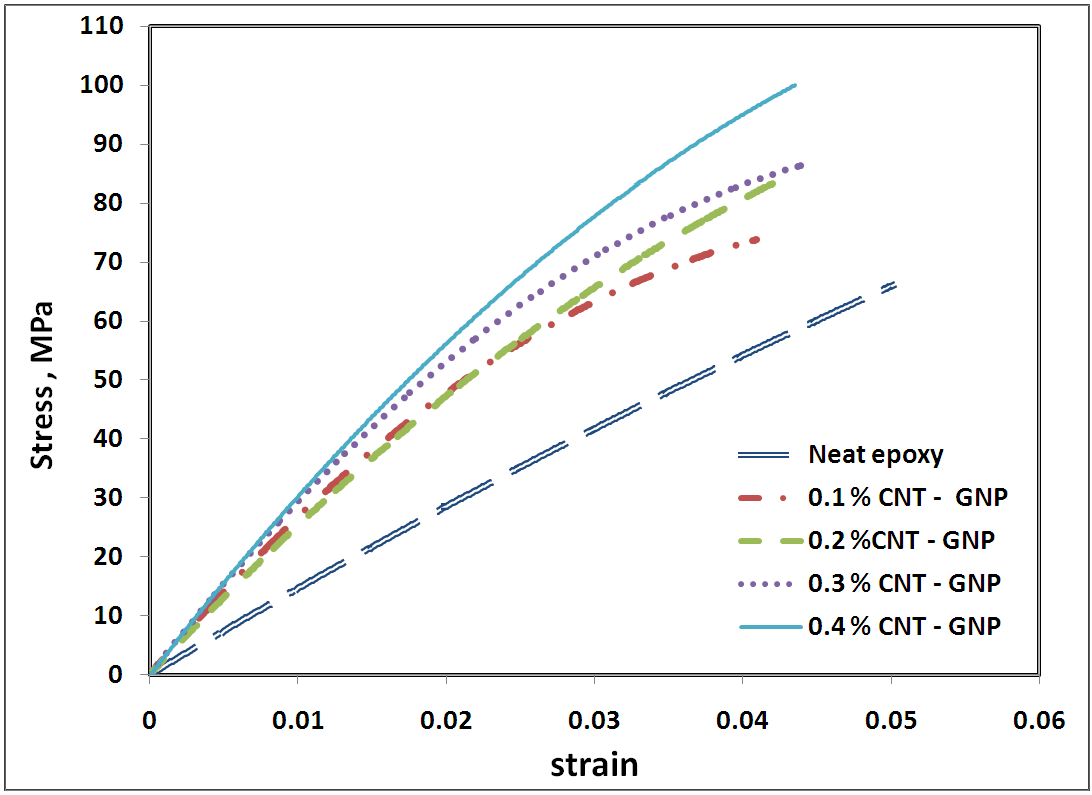 | Figure 2. Stress-strain curve of CNTs +GNPs /epoxy nanocomposites |
|
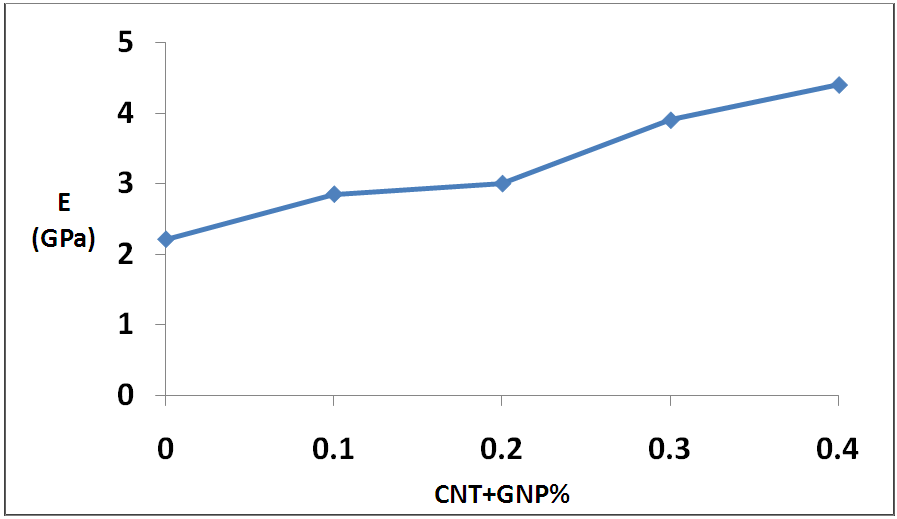 | Figure 3. Young modulus of CNT+GNP/epoxy |
3.3. Dispersion of CNT/GNP in Epoxy Matrix
- The dispersion of nanofiller in a polymer matrix has a direct correlation with its effectiveness in improving the mechanical properties. The architecture of graphene-CNT hybrids nanofiller can be classified into three types (Zhang and Liu, 2012) [22], (i) CNTs interact perpendicular to the GNPs; (ii) CNTs interact horizontal to the graphene sheets (GNPs); and (iii) CNTs were wrapped within GNPs as shown in Figure 4. In the horizontally interaction of CNTs / GNPs surfaces, the GNPs acted as a continuous sheet substrate for supporting the component of CNTs. The majority of GNP-CNT hybrids were fabricated in this form. In perpendicular interaction of CNTs with the GNPs surfaces, there is a single interaction point between the GNPs and CNTs which is the catalyst nanoparticles from CVD growth. CNTs wrapped within GNPs depend on the interaction types between CNTs and GNP and the initial CNTs / GNPs ratios [22]. Irreversible agglomeration of graphene via van der Waals interaction is found to be hindered in the presence of CNTs [23].
 | Figure 4. GNP-CNT hybrids (A) CNTs adsorbed perpendicular to the GNP; (B) CNT is wrapped by GNP; (C) CNT is horizontal to GNP |
3.4. Fracture Surface of CNT-GNP / Epoxy
- The FESEM microphotographs of CNT-GNP/Epoxy fracture Surface are shown in Figure 5 a - e. For 0.1% CNT-GNP/Epoxy fracture Surface, Figure 5b, CNTs and GNPs are separated individually, perhaps because of the amount of CNTs& GNPs is not enough to make π-π bond interaction and no 3-D hybrid arrangement. Similar behavior was observed for 0.2% CNT-GNP/Epoxy fracture Surface as shown in Figure 5c. This behavior is supported by the stress strain curves for CNT-GNP/Epoxy with 0.1 and 0.2% CNT-GNP at low strain. At higher CNT-GNPs %, FESEM image of 0.3% and 0.4% CNT-GNP/Epoxy fracture surface showed that 1-D CNTs and planar 2-D GNPs formed 3-D graphene-based architectures as shown in Figure 5 d, e. The long 1-D MWCNT can bridge adjacent 2-D GNPs and inhibit the aggregation of GNPs. This will increase the contact surface area between CNTs/GNPs structures and the epoxy matrix which is beneficial to their mechanical properties. Moreover, no holes or voids were found on the fracture surface. The addition CNTs significantly influences GNPs dispersion and the state of aggregation in the matrix. The smaller agglomerates not only decrease the incidence of defects, but also increase epoxy contact area, resulting in a synergetic improvement in composite properties. In general, surface functionalization of CNTs enhances adhesion and compatibility between CNTs and the epoxy matrix. It is interesting to note, that adding small amounts CNTs into a GPN/epoxy composite also increases adhesion and compatibility between CNT/GNP and the epoxy matrix. FESEM shows that GNP and CNT are both embedded in the matrix as shown in Figure 5d, e.The covalent bonding is present between epoxy group and functional group on the CNTs. CNTs aligns along the GNP surface by Van der Waals forces between graphene based structures. The flexible length of CNTs can act as chelating arms to improve bond between 3-D GNP/ CNT hybrid nanofillers and the matrix) [18].Figure 5e shows CNTs are deeply rooted in a few graphene sheets and form a 3-D architecture and CNTs are well connected to graphene floor. It is clear that CNTs are interacted horizontality and perpendicularly with GNPs forming 3-D structure at 0.3 and 0.4% CNT-GNP. This 3-D structure gives larger contact area between matrix and CNTs. Besides, the CNT bundles connect on GNP surface could prevent the plane to- plane aggregations of GNPs and nanocomposite interfacial properties are also improved. Therefore, CNTs has great effect on the dispersion of GNPs in the epoxy matrix. The third interaction where GNPs is wrapped around CNTs is not observed in this work.
 | Figure 5. FESEM microphotographs of CNT-GNP/Epoxy nanocomposites fracture Surface (a) Neat Epoxy; (b) 0.1% CNT-GNP; (c) 0.2% CNT-GNP; (d) and (e) 0.4% CNT-GNP |
3.5. Electrical Conductivity of CNT- GNP/Epoxy
- The electrical conductivity of CNT+GNP/ epoxy is shown in Figure 6. GNP and CNT have good electrical properties. When GNPs used as fillers with insulating polymer matrix, conductive graphene may greatly enhance the electrical conductivity of the composites. The electrical conductivity of epoxy with nano-fillers depends on many factors include the aggregation of filler, the presence of functional groups on graphene sheets, filler wt%, aspect ratio of GNPs dispersion in the matrix [25].
 | Figure 6. Electrical conductivity of epoxy nanocomposite |
3.6. Contact Angle of CNT-GNP/Epoxy Nanocomposite
- The static contact angles of water droplets on the epoxy nanocomposites with different CNT–GNP % and neat epoxy plate surfaces were measured by an optical microscope as shown in Figure 7.
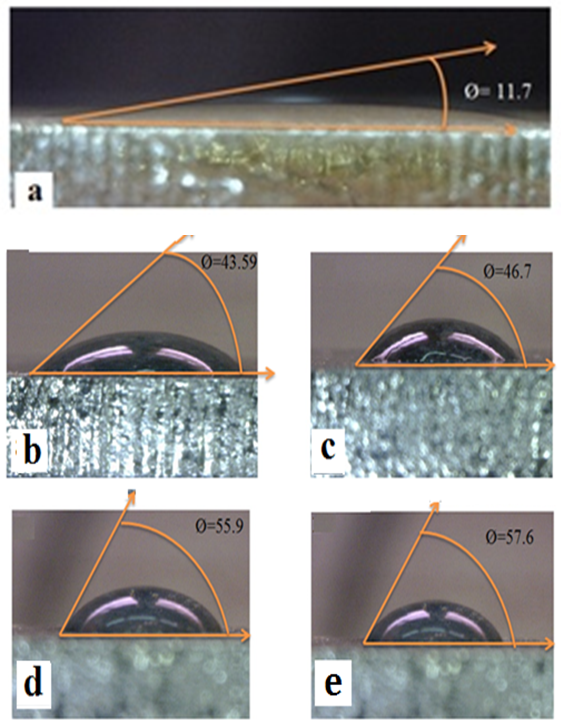 | Figure 7. Contact angle of (a) Neat epoxy; (b) 0.1% CNT-GNP/epoxy; (c) 0.2% CNT-GNP/epoxy; (d) 0.3% CNT-GNP/epoxy; (e) 0.4% CNT-GNP/epoxy |
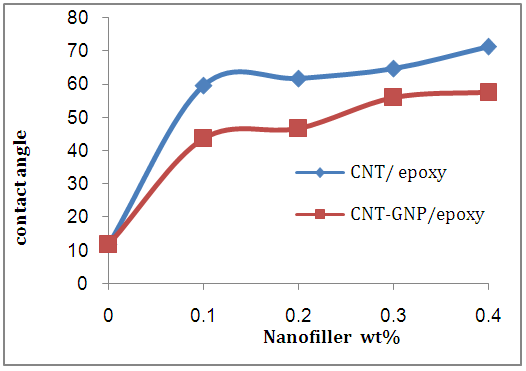 | Figure 8. Contact angle vs. Nanofiller wt% |
3.7. AFM of Epoxy Nanocomposite
- The AFM image of CNTs-GNPs epoxy is shown in Figure 13b. The sonication time (20 min) of CNTs-GNPs was sufficient to break up the CNT-GNP bundles and CNT are well dispersed with no aggregates in the epoxy matrix. This indicates the success of the dispersion process. From Figure 9 the GNPs is nearly the size of 2 microns (It is the same size before the shear mixing and sonication process) and this shows that the shear mixing and sonication processes were balanced and no breakage of GNPs.
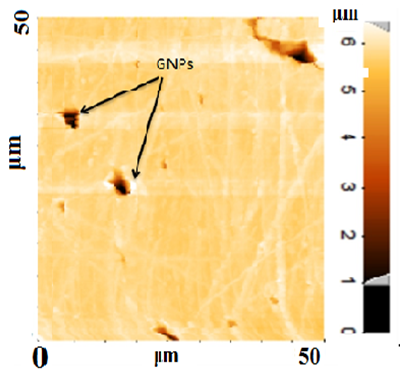 | Figure 9. AFM CNT+GNP / epoxy nanocomposite |
3.8. Water Absorption of CNT+GNP Nanocomposite
- Water absorption on CNT-GNP/epoxy nanocomposite surfaces decreases with increasing CNTs-GNPs % as shown in Figures 10. It was found that the maximum water uptake decreases gradually with increasing nano-filler [31]. The presence of high aspect ratio nano-fillers can create a tortuous pathway for water molecules to diffuse into the composites [32].
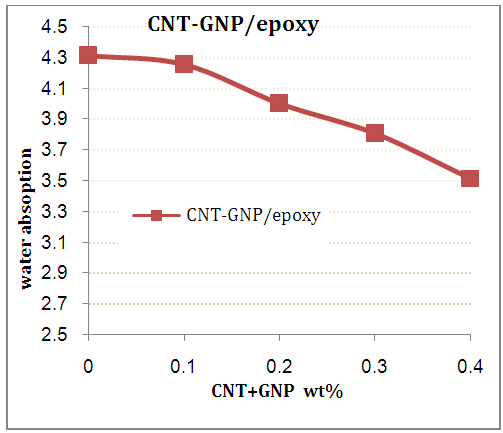 | Figure 10. Water absorption vs. CNT+GNP nano-filler |
4. Conclusions
- CNT-GNP/epoxy hybrid composites were prepare by shear mixing followed by sonication. The results showed that the mechanical and electrical properties of composites were significantly improved. It seems that addition of CNTs significantly influences GNPs dispersion in the matrix. The fracture surface of CNT-GNP/epoxy hybrid composites indicates that the CNTs with GNPs form 3-D hybrid structure which inhibits face to face aggregation of GNPs. This will increase the contact surface area between CNTs/GNPs structures and the epoxy matrix which is beneficial to their mechanical properties. The contact angle of CNT-GNP/epoxy is less than that of CNT /epoxy. This is because CNTs are intercalated by the conjugate regions on the graphene sheet via π-π stacking interactions as a result of shear mixing and sonication.
 Abstract
Abstract Reference
Reference Full-Text PDF
Full-Text PDF Full-text HTML
Full-text HTML